The IELTS Writing Task 1 often presents data in various formats, requiring test-takers to showcase their analytical and descriptive skills. Topics surrounding societal changes, like “Mental Health Awareness Campaigns (2000-2023),” have become increasingly prevalent. Understanding how to interpret and write about such data is crucial for achieving a Band 7+ score.
This article will delve into a potential IELTS Writing Task 1 scenario focusing on mental health awareness campaigns. We’ll analyze a sample data set, craft a model response, and provide essential vocabulary and grammatical structures to help you excel in this section.
Sample IELTS Writing Task 1
The table below shows the percentage of the population in three different countries who reported seeking help for mental health issues, along with government spending on mental health awareness campaigns, between 2000 and 2020.
Summarise the information by selecting and reporting the main features and make comparisons where relevant.
| Country | % Seeking Help (2000) | % Seeking Help (2020) | Govt. Spending on Campaigns (USD Million, 2000) | Govt. Spending on Campaigns (USD Million, 2020) |
|---|---|---|---|---|
| Country A | 10% | 18% | 20 | 55 |
| Country B | 25% | 30% | 40 | 60 |
| Country C | 15% | 35% | 15 | 80 |
Data Analysis
The table highlights the positive impact of mental health awareness campaigns on help-seeking behavior. Key observations include:
- Increased Help-Seeking: All three countries witnessed a significant rise in the percentage of people seeking help for mental health issues between 2000 and 2020.
- Government Spending Correlation: This positive trend coincides with increased government spending on mental health awareness campaigns in all three nations.
- Country C’s Remarkable Progress: Country C stands out with the most dramatic increase in both help-seeking behavior and government expenditure.
Model Answer
The provided table illustrates the changes in the percentage of individuals seeking mental health assistance and government spending on related campaigns in three countries from 2000 to 2020.
Overall, there is a clear upward trend in both help-seeking behavior and government investment in mental health awareness across all countries. However, the rate of change varies considerably.
In 2000, Country B had the highest percentage of its population seeking help (25%), while Country A had the lowest (10%). By 2020, the situation had shifted, with Country C experiencing a dramatic increase to 35%, surpassing both Country B (30%) and Country A (18%).
This shift aligns with the trends in government spending. While Country B initially allocated the most funds to mental health campaigns (USD 40 million), Country C significantly increased its spending to USD 80 million by 2020. This proactive approach appears to have contributed to the substantial rise in help-seeking behavior in Country C.
In conclusion, the data suggests a strong correlation between government investment in mental health awareness campaigns and a willingness to seek help for mental health issues. (Word Count: 178)
Writing Tips
- Clear Overview: Begin with a concise overview summarizing the key trends in the data.
- Selective Reporting: Focus on the most significant changes and avoid unnecessary details.
- Comparisons: Make clear comparisons between countries, time periods, or data categories.
- Data Accuracy: Ensure accurate representation of the data using appropriate vocabulary.
- Concise Language: Use clear and concise language, avoiding repetition and redundancy.
Essential Vocabulary
- Trend: A general direction of change (e.g., upward trend, downward trend).
- Correlation: A relationship between two or more things where they change together.
- Expenditure: The amount of money spent.
- Proactive: Taking action to prevent or control a situation.
- Significant: Important or noticeable.
Grammar Focus
- Comparatives and Superlatives: Use these to highlight differences (e.g., higher than, the highest).
- Prepositions: Pay close attention to prepositions when describing changes over time or comparing data points (e.g., increase in, decrease from, compared to).
- Tenses: Use the past tense for past data, the present tense for general statements, and the future tense (with appropriate qualifiers) for predictions.
Conclusion
Mastering the art of data analysis and description is crucial for success in the IELTS Writing Task 1. By understanding trends, using precise vocabulary, and employing accurate grammar, you can confidently tackle any data set related to “Mental Health Awareness Campaigns (2000-2023)” or other topical issues. Remember to practice regularly, analyze model answers, and seek feedback to refine your writing skills and achieve your desired Band score.
